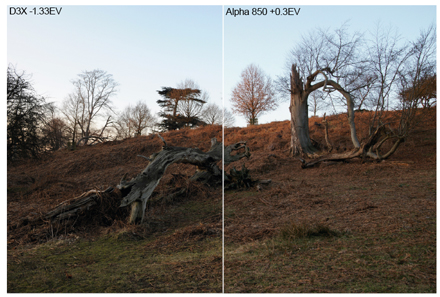Nikon D3X vs Sony Alpha 850 – Metering
Although centreweighted and spot metering suggest an exposure to achieve a mid-grey tone, what one manufacturer considers mid-grey can be slightly different from another’s. In real-life situations I found that the Nikon D3X and Sony Alpha 850 produced almost identical exposures, and when there was a difference it was generally only around 0.3EV.
However, I found there was more of a difference in how the cameras performed in their evaluative metering modes. Rather than simply having a camera average out the brightness of a scene, modern systems work by evaluating the scene as a whole and then working out the correct exposure.
Of the two evaluative metering modes, the D3X’s 1,005-segment 3D Colour Matrix is the more sophisticated. It uses the colour, brightness and contrast of a scene, as well as focusing information, to compare it to some 20,000 scenes that are kept in an internal database. The D3X then uses all
this information to determine what it thinks is the optimal exposure.
In practice I found that evaluative metered exposures from the two cameras were quite close, being around 1EV apart at most. Generally, it would seem as though the D3X tries to lighten shadow areas a little more than the Alpha 850, while the Alpha 850 tries to maintain highlight detail.

Image: How the cameras performed in evaluative metering mode varied from scene to scene. Here I had to reduce the exposure time of the D3X image as it was too light, while I had to lighten the shot from the Alpha 850
In situations where you wish to tweak the exposure quickly or where a series of images is being captured in the same conditions, the EV compensation button next to the shutter-release button on
both cameras comes in handy.
The Nikon D3X has a few more tricks up its sleeve, though. Whereas the Sony Alpha 850 has exposure bracketing of up to 2EV, the D3X is capable of up to a 9EV spread across a maximum of nine exposures. This is great when trying to make sure the exposure is exactly right, and it also makes it easy to produce HDR images. However, the Nikon D3X doesn’t stop there. Like other professional Nikon DSLR cameras, the D3X features a Fine Tune Optimal Exposure custom option. This allows the user to adjust the metered exposure of each of the centreweighted, spot and evaluative metering modes by as little as 1/6EV. So should you find that the D3X always produces exposures that are a little too dark in spot metering mode, you can adjust the metering to change this.
When the metering systems of both cameras are compared, the Nikon D3X has more options. However in their default settings there is little to separate the exposures of both cameras. There certainly isn’t enough of a difference to justify the extra expense of the D3X.




